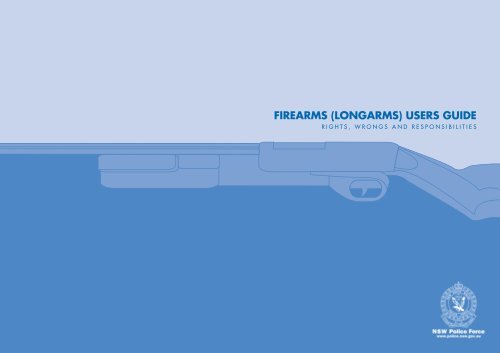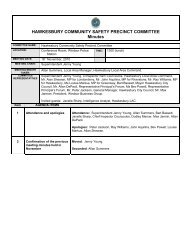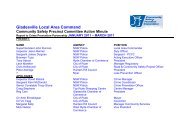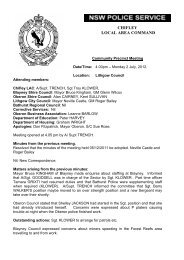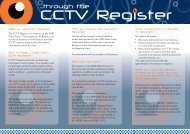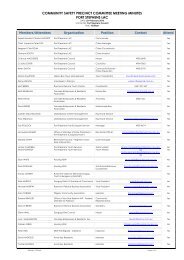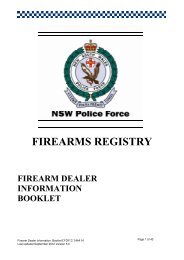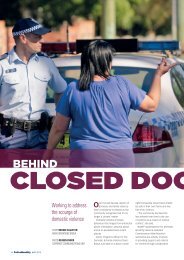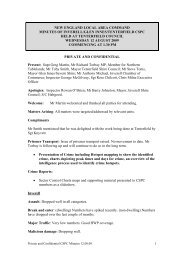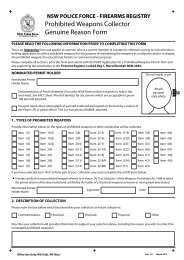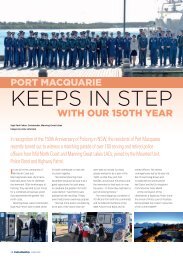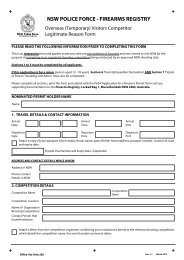Firearms (Longarms) User Guide - NSW Police Force
Firearms (Longarms) User Guide - NSW Police Force
Firearms (Longarms) User Guide - NSW Police Force
Create successful ePaper yourself
Turn your PDF publications into a flip-book with our unique Google optimized e-Paper software.
FIREARMS (LONGARMS) USERS GUIDE<br />
RIGHTS, WRONGS AND RESPONSIBILITIES
FIREARMS (LONGARMS) USERS GUIDE<br />
R I G H T S , W R O N G S A N D R E S P O N S I B I L I T I E S<br />
TITLE <strong>Firearms</strong> (<strong>Longarms</strong>) <strong>User</strong>s <strong>Guide</strong><br />
SUBJECT Rights, Wrongs and Responsibilities when using <strong>Firearms</strong> (<strong>Longarms</strong>)<br />
AVAILABLE TO Unrestricted<br />
PUBLICATION DATE September 2006<br />
VERSION Two<br />
REVIEW DATE September 2007<br />
PUBLICATION NUMBER 0000142<br />
ISBN I 876320 28 1
TABLE OF CONTENTS<br />
C H A P T E R 1 FIREARMS LICENCE QUALIFICATION COURSE<br />
2<br />
Why are there firearm laws? 5<br />
What is this course and why do I need to do it? 5<br />
C H A P T E R 2 DEFINITION OF A FIREARM<br />
What is a firearm? 7<br />
What are the main types of firearms? 7<br />
What are the major parts of a firearm? 9<br />
What are the basic functions of a firearm? 10<br />
What is ammunition? 10<br />
What are the different types of ammunition? 11<br />
What are the components of ammunition? 11<br />
C H A P T E R 3 USE AND SAFETY<br />
Basic firearms safety 13<br />
What is the National <strong>Firearms</strong> Safety Code? 14<br />
C H A P T E R 4 LICENCES AND PERMITS<br />
Why do I want or need a firearms licence? 15<br />
How do I apply for a firearms licence? 15<br />
Who can apply for a licence? 18<br />
Is there anything that may prevent me from getting a licence? 18<br />
What do I need to provide? 19<br />
How do I change my firearms licence? 19<br />
What happens if I lose my licence? 19<br />
What happens if my reasons for having a licence change? 19<br />
What happens if I breach a condition of my licence? 19<br />
When must I renew my licence? 19<br />
When might my licence be revoked or suspended? 20<br />
When might my firearms be confiscated by police? 20<br />
What else do I need to know? 20<br />
What is a permit and how is it different from a licence? 20<br />
What is a permit to acquire? 21<br />
C H A P T E R 5 BUYING AND REGISTERING A FIREARM<br />
How do I acquire a firearm? 22<br />
Where can I buy or sell a firearm? 22<br />
Can I borrow a firearm? 22<br />
Ammunition – how do I get it? 22<br />
What if I don’t want my firearm or ammunition any more? 22<br />
Do I need to register my firearm? 23<br />
Safe storage (<strong>Firearms</strong> and Ammunition) 23<br />
FIREARMS (LONGARMS) USERS GUIDE
C H A P T E R 6 MODIFYING A FIREARM OR AMMUNITION<br />
What components of my firearm may I change? 25<br />
What if my firearm breaks or needs repairs? 25<br />
Can I alter the appearance of my firearm? 25<br />
Can I increase the magazine capacity of my firearm? 26<br />
Is reloading the only alternative for ammunition? 26<br />
Are all other modifications to ammunition dangerous? 26<br />
What should I do if my firearm malfunctions or if I discover a fault with my firearm? 26<br />
What is the role of a club armourer in the safe maintenance of firearms? 26<br />
C H A P T E R 7 SHOOTING RANGES<br />
What is a shooting range? 27<br />
Why would I need to use one? 27<br />
What are my obligations when I use a shooting range? 27<br />
What are my range responsibilities? 27<br />
What are my responsibilities if I am shooting in a field environment? 28<br />
What does a range officer do?<br />
What is the maximum range (distance) of my firearm and ammunition<br />
28<br />
and what is beyond the target? 28<br />
C H A P T E R 8 LEGISLATION<br />
<strong>Firearms</strong> Act 1996 and <strong>Firearms</strong> Regulation 2006 29<br />
What are the principles and objects of the legislation? 29<br />
What is the role of <strong>NSW</strong> <strong>Police</strong> <strong>Force</strong> (Commissioner and <strong>Firearms</strong> Registry)? 30<br />
Complying with the law (including offences) 30<br />
Am I allowed use my firearm while intoxicated? 31<br />
C H A P T E R 9 RESPONSIBILITIES AND ETHICS<br />
What are my legal responsibilities? 32<br />
What are my social responsibilities? 32<br />
What should I do if become aware of an illegal activity? 32<br />
What could happen if a firearm is misused? 32<br />
How can I ensure my own safety and those around me? 33<br />
What is a duty of care? 33<br />
What do I need to do if there’s a firearm accident or injury? 33<br />
Am I obliged to render assistance?<br />
What is ethical behaviour and what are my responsibilities in relation to the<br />
33<br />
environment and animals? 33<br />
C H A P T E R 1 0 PRACTICAL COMPONENT<br />
Handling a firearm 35<br />
Using a firearm 35<br />
Maintenance 36<br />
FIREARMS (LONGARMS) USERS GUIDE 3
4<br />
FIREARMS (LONGARMS) USERS GUIDE
CHAPTER 1<br />
FIREARMS LICENCE QUALIFICATION COURSE<br />
Why are there firearm laws?<br />
<strong>NSW</strong> has firearm laws to protect public safety and promote the responsible and<br />
safe use of firearms.<br />
The <strong>Firearms</strong> Act 1996 (the <strong>Firearms</strong> Act) and the <strong>Firearms</strong> Regulation 2006<br />
(the <strong>Firearms</strong> Regulation) contain the rules you need to know to lawfully use<br />
and own a firearm in <strong>NSW</strong>. It is recommended that firearms users and owners<br />
read the legislation in order to understand their responsibilities.<br />
The current version of the legislation can be found at<br />
www.legislation.nsw.gov.au.<br />
What is this course and why do I need to do it?<br />
This is the <strong>Firearms</strong> Licence Qualification course and it is a requirement that<br />
all new firearms licence applicants in <strong>NSW</strong> complete and pass the course or a<br />
course approved by the Commissioner of <strong>Police</strong> (clause 122, <strong>Firearms</strong><br />
Regulation 2006).<br />
For information about what approved courses you may complete please contact<br />
the <strong>Firearms</strong> Registry Customer Service Line on 1300 362 562 or write to:<br />
<strong>Firearms</strong> Registry<br />
Locked Bag 1<br />
Murwillumbah <strong>NSW</strong> 2484<br />
Further information about the <strong>Firearms</strong> Registry is at:<br />
www.police.nsw.gov.au/about_us/structure/corporate_services/firearms<br />
The <strong>Firearms</strong> Licence Qualification course is for longarm firearm use or<br />
ownership only. Category H (handgun) licence applicants are required to<br />
undertake an approved pistol training course, administered by a pistol club.<br />
FIREARMS (LONGARMS) USERS GUIDE 5
FIREARMS LICENCE QUALIFICATION COURSE<br />
6<br />
At the end of this course, you will:<br />
■ Have a theoretical and practical understanding of firearms and firearms use;<br />
■ Know about firearms laws in <strong>NSW</strong>; and<br />
■ Understand your responsibilities in relation to firearm use and ownership<br />
and the requirements you must undertake to own or use a firearm in <strong>NSW</strong>.<br />
This course can either be conducted by your club or organisation or an approved<br />
person. It is your responsibility to ensure that your trainer, club or organisation<br />
has been approved to deliver the course. The <strong>Firearms</strong> Registry can advise you<br />
on which clubs or organisations offer approved courses.<br />
This course is an overview only. Please use this information as a starting block<br />
from which to learn more about firearms, the legislative environment, and safe<br />
and responsible use.<br />
Furthermore, to obtain your firearms licence qualification certificate you must<br />
undertake the practical component of the course. Your course trainer will<br />
explain what you will need to know about the safe handling and use of firearms.<br />
Further information on the practical component can be found in Chapter 10.<br />
FIREARMS (LONGARMS) USERS GUIDE
CHAPTER 2<br />
What is a firearm?<br />
THE BASICS<br />
The <strong>NSW</strong> <strong>Firearms</strong> Act defines a firearm as:<br />
A gun, or other weapon, that is (or at any time was) capable of propelling a<br />
projectile by means of an explosive and includes a blank fire firearm, or an air<br />
gun, but does not include anything declared by the Regulations not to be a<br />
firearm.<br />
What are the main types of firearms?<br />
<strong>Firearms</strong> are either longarms (fired from the shoulder) or handguns. Most<br />
modern longarms are either rifles or shotguns.<br />
A rifle derives its name from its rifled barrel (i.e. grooves and lands or ridges on<br />
the inside of the barrel). The rifling causes the projectile to spin on its axis,<br />
leading to greater accuracy and a longer range.<br />
Shotguns usually have a smoothbore barrel (i.e. a barrel without rifling – lands<br />
and grooves) and fires slugs or pellets. These firearms are usually used for<br />
moving targets.<br />
Handguns include revolvers and pistols. Handguns are different from longarms<br />
as they do not have a shoulder stock and are generally designed to be held in<br />
the hand or hands of the shooter.<br />
A revolver has a revolving cylinder in which a limited number of cartridges can<br />
be held.<br />
A pistol has a single fixed firing chamber and holds its cartridges either within<br />
the chamber or in a removable magazine. A pistol is reasonably capable of being<br />
raised and fired by one hand and must not exceed a prescribed dimension.<br />
The following are the main types of actions for firearms. They are common in<br />
longarms but some actions can be found in handguns.<br />
FIREARMS (LONGARMS) USERS GUIDE 7
THE BASICS<br />
8<br />
AIR RIFLES OR AIR PISTOLS<br />
In an air rifle or an air pistol, the projectile is propelled by compressed air (this<br />
may include any gas or mixture of gases but does not include a mixture of gases<br />
generated by an explosive) or by means of a spring. Air rifles are also known as<br />
BB guns, pneumatic guns or pellet guns.<br />
MUZZLE LOADING FIREARMS<br />
Muzzle loading firearms require a measured amount of powder to be poured<br />
down the barrel of the firearm and a lead ball or bullet follows. A small hole (a<br />
flash hole) is located near the trigger and a spark/flash caused by a flint lock or<br />
percussion cap lock is used to ignite the powder to create the propulsion for the<br />
projectile.<br />
BREAK-OPEN SINGLE OR DOUBLE BARREL FIREARMS<br />
Opening the action of a break open single or double barrel firearm reveals<br />
whether it is loaded. When the firearm is open it cannot be fired. Generally,<br />
break open firearms do not have a mechanical reloading mechanism, such as a<br />
magazine, and must be hand-loaded after each shot.<br />
BOLT ACTION FIREARMS<br />
Bolt action firearms operate by opening and closing a bolt, similar to a door bolt.<br />
The bolt can be lifted up and back to see whether the chamber is loaded.<br />
Generally, if the chamber is loaded a cartridge is ejected when the bolt is opened.<br />
LEVER ACTION FIREARMS<br />
Lever action firearms have a lever or handle located under, near or as part of<br />
the trigger guard. The firearm is opened by operating the lever, which reveals<br />
whether the chamber is loaded.<br />
SLIDE OR PUMP ACTION FIREARMS<br />
These firearms have a mechanism which can be slid or pumped to open the<br />
action to reveal whether the chamber is loaded.<br />
REPEATING AND SELF-LOADING FIREARMS<br />
Self-loading or repeating firearms are those that automatically recock or have to<br />
be manually operated to load the next round from the magazine. These fire one<br />
cartridge per pull of the trigger. Self-loaders can also be called semi-automatic<br />
firearms.<br />
FIREARMS (LONGARMS) USERS GUIDE
THE BASICS<br />
What are the major parts of a firearm?<br />
ACTION<br />
The action is the working mechanism of a firearm, for example, bolt action. It<br />
contains the moving components of the firearm that enable loading, firing,<br />
unloading and ejection of the used cartridge casings.<br />
RECEIVER<br />
The receiver is the frame which contains the operating (or moving) parts of the<br />
firearm and includes the breech (which is usually the part of the barrel that<br />
includes the chamber into which a cartridge or projectile is loaded) and firing<br />
mechanism.<br />
BOLT<br />
The bolt blocks the rear of the chamber and is a mechanical moving part of a<br />
firearm.<br />
TRIGGER MECHANISM<br />
The trigger is part of the firing mechanism and is the starting point for firing.<br />
The trigger mechanism includes the trigger, which, when pulled, releases what<br />
is generally referred to as a hammer. The hammer strikes the firing pin or<br />
primer directly (depending on the firing mechanism).<br />
BARREL<br />
The barrel is a hollow tube through which the projectile passes upon firing.<br />
The end of the barrel where the projectile exits is the muzzle. The inside of the<br />
barrel is the bore.<br />
STOCK<br />
This term is usually used for longarm firearms and refers to the end of the<br />
firearm which is positioned into the shoulder for the purpose of supporting the<br />
firearm during aiming and firing and transferring some of the recoil. The part<br />
of the firearm, which is under the receiver and barrel, is called the fore-end<br />
stock.<br />
MAGAZINE (IF APPLICABLE)<br />
A magazine is an internal or external container for cartridges. An external<br />
magazine can be detachable.<br />
FIREARMS (LONGARMS) USERS GUIDE 9
THE BASICS<br />
What are the basic functions of a firearm?<br />
10<br />
FEED/LOAD<br />
The process of placing a cartridge into the chamber of a firearm.<br />
COCK<br />
Placing a firearm into a condition where it can be discharged.<br />
LOCK<br />
The firearm breech, bolt and breech face come together providing a securely<br />
sealed unit, fully supporting the cartridge.<br />
FIRE<br />
This is the process of discharging a cartridge. Pulling the trigger operates<br />
internal components of a firearm which ultimately result in the forward<br />
movement of the firing pin. As the firing pin moves forward it strikes the<br />
primer of the cartridge. The primer is the means of ignition of a cartridge.<br />
The impact of the firing pin on the primer causes the priming compound inside<br />
the primer to ignite; this causes the propellant inside the cartridge case to start<br />
burning. As the propellant burns a build up of hot gases occurs. This build up<br />
of gas then forces the bullet out of the cartridge case and down the barrel of the<br />
firearm and out of the muzzle.<br />
UNLOCK<br />
The firearm breech, bolt and breech face separate and the support for the<br />
cartridge is removed.<br />
EXTRACT<br />
The act of withdrawing a cartridge or cartridge case from the chamber of a<br />
firearm.<br />
EJECT<br />
The act of expelling a cartridge or cartridge case from a firearm.<br />
What is ammunition?<br />
Ammunition is a general term meaning a cartridge with its projectile and<br />
propellant and primer.<br />
Projectiles, such as those fired from rifles or handguns, are called bullets. A<br />
“round” contains a bullet, primer, cartridge case and propellant. A shotgun does<br />
not usually discharge bullets, but generally projects in a single discharge a large<br />
number of small pellets (projectiles or shot).<br />
FIREARMS (LONGARMS) USERS GUIDE
THE BASICS<br />
What are the different types of ammunition?<br />
CENTREFIRE (RIFLE, HANDGUN AND SHOTGUN)<br />
The primer in centrefire ammunition is contained in the middle of the cartridge<br />
case head. The primer can be replaced, which means that many centrefire<br />
cartridges can be reloaded.<br />
RIMFIRE (RIFLE AND HANDGUN)<br />
The primer in rimfire cartridges is found around the inner edges of the<br />
cartridge case. Rimfire cartridges are generally limited to the lower pressure<br />
calibres as they often have a thin case. They cannot be reloaded and most<br />
modern rimfire cartridges do not exceed .22 calibre.<br />
MUZZLE LOADED<br />
What are the components of ammunition?<br />
Ammunition for muzzle loading firearms consists of a measured amount of<br />
gunpowder followed by an appropriate sized round lead ball, shaped projectile or<br />
a shot load along with any patch, card or wad necessary for the specific type of<br />
muzzle loading firearm being used.<br />
CARTRIDGE<br />
A cartridge is also referred to as a “round”. It comprises the bullet (projectile),<br />
propellant (gunpowder) and the primer (ignition), which all fit into the<br />
cartridge casing.<br />
PROJECTILE<br />
The projectile (bullet) is the item that ejects rapidly from the muzzle.<br />
PROPELLANT POWDER<br />
Propellant powder is material, such as gunpowder, which includes both<br />
blackpowder and smokeless powder. It burns quickly and controllably to<br />
produce gas, which under pressure forces the projectile to be expelled out of the<br />
muzzle.<br />
PRIMER<br />
In cartridges, the primer is held at the base of the cartridge and contains a<br />
sensitive chemical that ignites on impact. When the firing pin strikes the<br />
primer, it ignites with a spark, which then ignites the propellant powder.<br />
FIREARMS (LONGARMS) USERS GUIDE 11
THE BASICS<br />
12<br />
SHOTGUN PELLETS<br />
A shotgun shell contains a number of pellets (shot), which spread out when<br />
fired.<br />
At the end of this chapter you must be able to:<br />
■ Identify the main types of firearms<br />
■ Identify the major parts of firearms<br />
■ Identify the main functions of a firearm<br />
■ Identify ammunition components<br />
Sample question: What is NOT a component of ammunition?<br />
(a) primer<br />
(b) bullet<br />
(c) bolt<br />
(d) cartridge case<br />
FIREARMS (LONGARMS) USERS GUIDE<br />
The correct answer is (c) bolt
CHAPTER 3<br />
USE AND SAFETY<br />
Basic firearms safety<br />
There are four basic rules to ensure firearms safety:<br />
a) Treat all firearms as if they are loaded;<br />
b) Always point your firearm in a safe direction (never allow the muzzle of your<br />
firearm to point at another human being);<br />
c) Never load a live round into the chamber of a firearm until you are ready to<br />
shoot; and<br />
d) Keep your finger off the trigger until you are ready to shoot.<br />
When handling a firearm always remember that safety is your top priority.<br />
Always follow these general principles:<br />
■ When passing a firearm to someone or when picking a firearm up, check<br />
whether the firearm is loaded by opening the action and looking inside the<br />
chamber;<br />
■ Your firearm is your responsibility;<br />
■ Positively identify your target, always ensure that the firing zone is clear and<br />
identify what is beyond your target;<br />
■ When you have finished shooting remove the magazine (if fitted), unload and<br />
check that the chamber is empty;<br />
■ Make sure that all firearms are transported securely to prevent misuse or<br />
theft;<br />
■ Never allow unauthorised access to your firearm or ammunition;<br />
■ Do not climb fences or obstacles with loaded firearms;<br />
■ Encourage safe and responsible handling of firearms in the field, on the<br />
range and within the community;<br />
FIREARMS (LONGARMS) USERS GUIDE 13
USE AND SAFETY<br />
14<br />
■ Understand the operation of your firearm, keep it in good repair and always<br />
use the correct ammunition;<br />
■ Never store firearms and ammunition together. Ensure they are safely<br />
locked away when not in use;<br />
■ Never mix shooting with alcohol or drugs;<br />
■ Be familiar with the legal requirements for safe storage, firearms ownership,<br />
possession and use in <strong>NSW</strong> or in any state or territory you may visit; and<br />
■ Dispose of unwanted firearms lawfully. Surrender them to police or sell them<br />
to or through a licensed firearms dealer.<br />
What is the National <strong>Firearms</strong> Safety Code?<br />
The National <strong>Firearms</strong> Safety Code provides instruction on the safe handling<br />
procedures and safe shooting practices for firearms. Newcomers must<br />
familiarise themselves with the Code and trainers are encouraged to explain the<br />
Code to newcomers. The National <strong>Firearms</strong> Safety Code can be obtained from<br />
the <strong>Firearms</strong> Registry by phoning the Customer Service Line on 1300 362 562.<br />
Further information about the safe use of firearms is addressed in the practical<br />
component in chapter 10.<br />
At the end of this chapter you must be able to:<br />
■ Identify basic firearms safety<br />
Sample question: Which of the following is good advice for a firearms user?<br />
(a) never mix shooting with alcohol<br />
(b) it’s okay to climb over fences with a loaded firearm<br />
(c) always keep your firearms and ammunition stored together<br />
(d) it’s okay to shoot at abandoned buildings<br />
FIREARMS (LONGARMS) USERS GUIDE<br />
The correct answer is (a) never mix shooting with alcohol
CHAPTER 4<br />
LICENCES AND PERMITS<br />
Why do I need a firearms licence?<br />
If you want to use or possess a firearm for personal or professional reasons in<br />
<strong>NSW</strong> you must have a licence or permit.<br />
A few people or professions are exempt from the need to hold a licence while<br />
acting in the ordinary course of their duties, for example, defence force<br />
personnel, custodial officers or police officers.<br />
How do I apply for a firearms licence?<br />
To apply for a firearms licence you must:<br />
DETERMINE WHETHER YOU HAVE A GENUINE REASON FOR OWNING OR USING<br />
A FIREARM<br />
Under the <strong>Firearms</strong> Act, all licence applicants are required to provide a<br />
“genuine reason” for use or possession of a firearm. These are:<br />
■ Sport/target shooting;<br />
■ Recreational hunting/vermin control;<br />
■ Primary production;<br />
■ Vertebrate pest animal control;<br />
■ Business or employment;<br />
■ Occupational requirements relating to rural purposes;<br />
■ Animal welfare; and<br />
■ <strong>Firearms</strong> collection.<br />
All applicants must provide proof of their genuine reason and must fulfil a<br />
range of requirements depending on what genuine reason is supplied.<br />
Applicants are only authorised to use a firearm for the purpose stated on the<br />
licence. For example, if the genuine reason of target shooting is provided, the<br />
applicants is not authorised to use a firearm for the purposes of hunting.<br />
FIREARMS (LONGARMS) USERS GUIDE 15
LICENCES AND PERMITS<br />
16<br />
An applicant may provide more than one genuine reason on their licence<br />
application; however, they are required to fulfil all the requirements for each<br />
genuine reason.<br />
DETERMINE WHAT CATEGORY OF LICENCE IS APPROPRIATE FOR YOUR NEEDS<br />
The <strong>Firearms</strong> Act has seven licence categories (A, B, C, D, H, firearms dealing<br />
and firearms collecting). The different licence categories relate to different<br />
categories of firearms or different activities (i.e. dealing and collecting).<br />
Additional requirements apply to categories B, C, D and H licences. The<br />
firearms licence categories are as follows:<br />
Category A licence<br />
<strong>Firearms</strong> to which the licence applies:<br />
■ air rifles;<br />
■ rimfire rifles (other than self-loading);<br />
■ shotguns (other than pump action or self-loading); and<br />
■ shotgun / rimfire rifle combinations.<br />
For all categories of licence other than Category A, an applicant must provide<br />
evidence to the satisfaction of the Commissioner that there is a special need for<br />
the person to possess or use a firearm of that category.<br />
Category B licence<br />
<strong>Firearms</strong> to which the licence applies:<br />
■ muzzle-loading firearms (other than pistols);<br />
■ centre-fire rifles (other than self-loading); and<br />
■ shotgun/centre-fire rifle combinations.<br />
All prohibited firearms are excluded from this licence category.<br />
Category C licence<br />
<strong>Firearms</strong> to which the licence applies:<br />
■ self-loading rimfire rifles with a magazine capacity of no more than 10<br />
rounds;<br />
■ self-loading shotguns with a magazine capacity of no more than 5 rounds;<br />
and<br />
■ pump action shotguns with a magazine capacity of no more than 5 rounds.<br />
A category C licence is prohibited expect for limited purposes and is restricted<br />
to persons who cite the genuine reason of primary production (and in some<br />
special circumstances, clay target shooting).<br />
FIREARMS (LONGARMS) USERS GUIDE
LICENCES AND PERMITS<br />
Category D licence<br />
<strong>Firearms</strong> to which the licence applies:<br />
■ self-loading centre-fire rifles;<br />
■ self-loading rimfire rifles with a magazine capacity of more than 10 rounds;<br />
■ self-loading shotguns with a magazine capacity of more than 5 rounds;<br />
■ pump action shotguns with a magazine capacity of more than 5 rounds; and<br />
■ any firearm to which a category C licence applies.<br />
These firearms are prohibited except for official purposes and can only be used<br />
for the purposes of vertebrate pest animal control.<br />
Category H licence (pistols)<br />
<strong>Firearms</strong> to which the licence applies:<br />
■ pistols (including blank fire pistols and air pistols).<br />
(Note: under the <strong>Firearms</strong> Act, the term “pistols” includes “revolvers”)<br />
Handguns can only be possessed or used for certain strictly limited purposes,<br />
including business or employment or target shooting.<br />
<strong>Firearms</strong> Dealers Licence<br />
<strong>Firearms</strong> to which the licence applies:<br />
■ the kinds of firearms specified in the licence.<br />
Collector’s Licence<br />
<strong>Firearms</strong> to which the licence applies:<br />
■ the kinds of firearms specified in the licence.<br />
In general, post-1946 pistols and any prohibited firearm (other than those<br />
firearms to which a category C licence or category D licence applies) are<br />
excluded from this licence category.<br />
Applicants must note that a range of restrictions and responsibilities apply to<br />
all licence categories.<br />
The following pistols are prohibited from ownership unless authorised by a<br />
special permit:<br />
■ a pistol with a calibre of more than .38 inch;<br />
■ a self-loading pistol with a barrel length of less than 120 mm;<br />
■ a revolver with a barrel length of less than 100 mm, but does not include any<br />
such kind of pistol that is a black powder pistol.<br />
FIREARMS (LONGARMS) USERS GUIDE 17
LICENCES AND PERMITS<br />
18<br />
COMPLETE THE FIREARMS LICENCE QUALIFICATION COURSE OR A COURSE<br />
APPROVED BY THE COMMISSIONER<br />
Your licence application cannot be approved without providing proof of<br />
completion of an approved firearms licence qualification course.<br />
CONTACT THE FIREARMS REGISTRY TO OBTAIN THE NECESSARY FORMS<br />
You can only obtain the necessary forms from the <strong>Firearms</strong> Registry. These<br />
forms are specifically designed for electronic scanning and cannot be<br />
photocopied and must be fully completed.<br />
Complete the application forms and forward with supporting documentation as<br />
required to support the genuine reason you have applied for.<br />
AWAIT APPROVAL FROM THE FIREARMS REGISTRY<br />
If your licence application is approved by the <strong>Firearms</strong> Registry, you will be sent<br />
a notice to collect your firearms licence from the Roads and Traffic Authority.<br />
Only the successful applicant is permitted to collect the firearm licence in person.<br />
Who can apply for a licence?<br />
A licence applicant must be:<br />
■ At least 18 years of age;<br />
■ Except in the case of a <strong>Firearms</strong> Dealer or where the applicants genuine<br />
reason is Business/Employment a ‘natural’ or living person (i.e. not a<br />
business name); and<br />
■ A <strong>NSW</strong> resident or about to become a resident of <strong>NSW</strong>.<br />
If you are under 18 years of age, you may apply for a minor’s firearms permit.<br />
Further information on minor’s permits can be found in the section on permits<br />
in this chapter.<br />
Is there anything that may prevent me from getting a licence?<br />
You will be prevented from getting a licence if, in the past ten years, you have<br />
committed a:<br />
■ <strong>Firearms</strong> offence (or you are subject to a firearms prohibition order);<br />
■ A prohibited drugs or a prescribed restricted substances offence;<br />
■ An offence involving violence;<br />
■ Offences of a sexual nature;<br />
■ Terrorist offences;<br />
■ You are the subject of an Apprehended Violence Order; or<br />
■ You are the subject of a Good Behaviour Bond.<br />
Additionally, you will be refused a licence if it is considered that you are not a fit<br />
and proper person and cannot be trusted to have possession of a firearm<br />
without harm to public safety or peace. Discretionary grounds for refusal are<br />
also contained with in the Act.<br />
FIREARMS (LONGARMS) USERS GUIDE
LICENCES AND PERMITS<br />
What do I need to provide?<br />
To obtain a licence you must:<br />
■ Prove your identity (the “100 points test”);<br />
■ Proof of the genuine reason (such as club membership)<br />
■ Provide proof of completing this course or an approved <strong>Firearms</strong><br />
Qualification Course; and<br />
■ Pay the relevant fee.<br />
Furthermore, the Commissioner must be satisfied that the storage and safety<br />
requirements are understood and capable of being met by the applicant (see<br />
chapter 5 for further information on safe storage).<br />
How do I change my firearms licence?<br />
To change any detail on your firearms licence you must contact the <strong>Firearms</strong><br />
Registry and obtain the necessary forms.<br />
What happens if I lose my licence?<br />
If you lose your licence you must notify the <strong>Firearms</strong> Registry in writing within<br />
fourteen (14) days.<br />
What happens if my reasons for having a licence change?<br />
If the reasons for your having a licence change (for example, if the genuine<br />
reason for possessing and using your firearm can no longer be established), you<br />
must inform the <strong>Firearms</strong> Registry in writing within fourteen (14) days.<br />
For example, if you have a firearm for the purpose of farming (primary<br />
production) and you sell your farm, you no longer have a genuine reason for<br />
owning a firearm.<br />
What happens if I breach a condition of my licence?<br />
Depending on the severity of the breach, you may lose your licence, incur a fine<br />
or face imprisonment.<br />
When must I renew my licence?<br />
The term of a licence is generally up to 5 years. It is your responsibility to<br />
ensure that you renew your licence on time. If you do not receive a renewal<br />
notification from the <strong>Firearms</strong> Registry prior to the expiration of your licence,<br />
please contact the <strong>Firearms</strong> Registry.<br />
If you choose not to renew your licence, you must dispose of your firearms<br />
legally before your licence expires (see chapter 5 for further information about<br />
the safe disposal of firearms).<br />
FIREARMS (LONGARMS) USERS GUIDE 19
LICENCES AND PERMITS<br />
When would my licence be revoked or suspended?<br />
A licence must be revoked or suspended if:<br />
20<br />
■ You are the subject of a firearms prohibition order or an Apprehended<br />
Violence Order;<br />
■ You are no longer a person to whom a licence can be granted, for example, if<br />
you are convicted of a drug or violence offence; or<br />
■ If you are an armed security guard and you fail to undertake your firearms<br />
safety training course.<br />
A licence may be revoked or suspended if:<br />
■ You supply false or misleading information;<br />
■ You breach the <strong>Firearms</strong> Act or Regulation;<br />
■ You breach a condition on your licence;<br />
■ Your firearm is stolen due to negligence or fraudulent activity; or<br />
■ If it is no longer in the public interest that you hold a firearms licence.<br />
When may my firearms be confiscated by police?<br />
Your firearms may be confiscated by police if your licence is suspended or<br />
revoked or if your registration has been cancelled. If this occurs, you must<br />
immediately surrender your firearms and licence to a police officer.<br />
What else do I need to know?<br />
As a licence holder you have a range of activities that you must undertake so<br />
that you can prove that your reason for holding a firearms licence is genuine.<br />
For example, if your genuine reason is target shooting, then each year you must<br />
participate in four club organised competitive shooting matches. If you are a<br />
member of a hunting club, you are required to participate in no less than two<br />
club organised events.<br />
Be aware of your responsibilities so that you fulfil the necessary<br />
requirements of your licence category and genuine reason!<br />
What is a permit and how is it different from a licence?<br />
The permit system was created to ensure that people who demonstrated a<br />
legitimate reason for firearm use or possession could be authorised to own or<br />
use a firearm.<br />
The <strong>Firearms</strong> Act requires that to use or possess a firearm you must be<br />
authorised by a licence or permit. You may apply for a licence if you can provide<br />
a genuine reason for using or possessing a firearm (see above). However, some<br />
people may have valid or legitimate reasons for using or possessing a firearm<br />
FIREARMS (LONGARMS) USERS GUIDE
LICENCES AND PERMITS<br />
but these reasons do not fall within the genuine reason categories. For example,<br />
a theatrical armourer (someone who supplies firearms for film, television or<br />
theatre) has a valid reason for possessing a firearm and should not be prevented<br />
from pursuing his or her vocation.<br />
For example, permits may be provided for the purposes of:<br />
■ Possessing a firearm as an heirloom;<br />
■ Ammunition collection;<br />
■ Using a high calibre firearm in special target shooting competitions;<br />
■ Theatrical armoury or film, theatre and television production;<br />
■ Displays at RSLs and museums; and<br />
■ Paintball.<br />
Permits can also be obtained for under 18s. An applicant must be over 12 years<br />
old, must have completed this course or an approved course prior to applying<br />
and must have the written consent of a parent or guardian. A minor can only<br />
get a permit for the purposes of firearms training or target shooting.<br />
What is a permit to acquire?<br />
If after obtaining your licence or permit, you would like to acquire a firearm you<br />
must first obtain a Permit To Acquire (PTA). A separate PTA is required for<br />
each firearm.<br />
A PTA will only be approved if the <strong>Firearms</strong> Registry is satisfied that you have<br />
a good reason for acquiring that firearm. A PTA can only be approved 28 days<br />
after the application has been lodged.<br />
At the end of this chapter you must be able to:<br />
■ Identify one genuine reason for firearms ownership<br />
■ Identify the different categories of firearms<br />
■ Provide one reason for which your firearms licence may be revoked<br />
■ Explain when you need to get a permit to acquire<br />
Sample question: Which of the following is NOT a Category A or B firearm?<br />
(a) muzzle loaded longarm<br />
(b) self-loading rifle<br />
(c) air rifle<br />
(d) rimfire rifle<br />
The correct answer is (b) self-loading rifle<br />
FIREARMS (LONGARMS) USERS GUIDE 21
CHAPTER 5<br />
BUYING, REGISTERING AND SAFELY<br />
STORING YOUR FIREARM<br />
How do I acquire a firearm?<br />
Prior to acquiring a firearm you must have:<br />
■ A valid licence or permit;<br />
■ A permit to acquire; and<br />
■ Suitable safe storage.<br />
Where can I buy or sell a firearm?<br />
You may only buy or sell a firearm from or through a licensed firearms dealer. If<br />
a licensed firearms dealer is unavailable (i.e. both the seller and the buyer live<br />
more than 100 kilometres from a licensed dealer), the sale must be witnessed by<br />
a police officer.<br />
Can I borrow a firearm?<br />
Yes. You may borrow a registered firearm from an authorised licence holder if<br />
you are authorised to use that category of firearm.<br />
Ammunition – how do I get it?<br />
You may buy ammunition from a firearms dealer or a licence or permit holder<br />
who is authorised to hold the relevant licence or permit for a firearm which<br />
takes that ammunition. To purchase ammunition you must hold a relevant<br />
licence or permit for a firearm which takes that ammunition.<br />
What if I don’t want my firearm or ammunition anymore?<br />
If you no longer want your firearm or ammunition you must dispose of them in<br />
a responsible manner.<br />
22<br />
FIREARMS (LONGARMS) USERS GUIDE
BUYING, REGISTERING AND SAFELY STORING YOUR FIREARM<br />
You must either:<br />
■ Sell the firearm and ammunition to or through a dealer; or<br />
■ Surrender the firearm and ammunition to the police.<br />
If you happen to come across a firearm that you are not authorised to have, you<br />
must immediately surrender it to the police.<br />
Do I need to register my firearm?<br />
All firearms, unless they are exempt, must be registered. Only very limited<br />
types of pre-1900 firearms are exempt from registration. The <strong>Firearms</strong> Registry<br />
maintains a central registry of firearms that includes information on the<br />
particulars of the firearm to enable its identification, such as the serial number<br />
of the firearm. It is an offence to be in possession of an unregistered firearm.<br />
Safe storage (<strong>Firearms</strong> and Ammunition)<br />
The <strong>Firearms</strong> Act sets out your responsibilities as a firearms owner in relation<br />
to safe storage. The <strong>Firearms</strong> Registry can provide you with a set of guidelines<br />
to assist in complying with safe storage laws. If you want to make sure that you<br />
comply with safe storage requirements, contact the Customer Service line at the<br />
<strong>Firearms</strong> Registry on 1300 362 562.<br />
Safe storage of firearms and ammunition is essential to ensure that your firearm<br />
does not fall into the wrong hands such as children, relatives or criminals.<br />
Remember, it is illegal to lend your firearm to an unauthorised person.<br />
Different categories of licence require different standards of safe storage.<br />
However, across all licences and permit categories, the legislation provides that<br />
any firearms owner must take all reasonable precautions to ensure that the<br />
firearm:<br />
■ Is kept safe;<br />
■ Is not lost or stolen; and<br />
■ Does not come into the possession of a person who is not authorised to<br />
possess the firearm.<br />
If you do not comply with these measures, you may lose your licence, incur a<br />
fine or go to prison.<br />
When at home and your firearm is not actually being used or carried, holders of<br />
category A and B licences must:<br />
■ Store the firearm in a locked receptacle that is constructed of hard wood or<br />
steel and not easily penetrable; and<br />
■ Store ammunition for the firearm in a locked container separate from the<br />
firearm.<br />
FIREARMS (LONGARMS) USERS GUIDE 23
BUYING, REGISTERING AND SAFELY STORING YOUR FIREARM<br />
24<br />
If the receptacle weighs less than 150 kilograms when empty, it must be fixed in<br />
order to prevent its easy removal and the locks must be of solid metal and be of<br />
an approved type.<br />
When at home and your firearm is not actually being used or carried, holders of<br />
category C and D licences must:<br />
■ Store the firearm in a locked steel safe (bolted to the structure of the<br />
premises) that cannot be easily penetrated; and<br />
■ Store ammunition for the firearm in a locked container separate from the<br />
firearm.<br />
While transporting your firearm you must ensure that it is conveyed in a safe<br />
and responsible manner, taking all reasonable steps to ensure the firearm is not<br />
stolen or unlawfully used. For example, when transporting a firearm, ensure the<br />
firearm is not loaded and render the firearm temporarily inoperable (i.e. cannot<br />
fire) by: removing the bolt from the firearm or fitting a trigger lock (or other<br />
commercial device); and locking the firearm out of visual sight, such as in the<br />
boot of the car. If you cannot fit the firearm in the boot, then ensure the firearm<br />
is covered from view and the vehicle is locked. Any ammunition must be locked<br />
in a separate container inside the vehicle, for example in the locked glove box.<br />
In addition to these requirements, the <strong>Firearms</strong> Registry will inform you what<br />
extra precautions you must take to ensure that your firearm does not get lost or<br />
stolen.<br />
At the end of this chapter you must know:<br />
■ Where or how you may lawfully buy or acquire a firearm<br />
■ How to dispose of your firearm or ammunition<br />
■ General principles relating to safe storage of firearms and ammunition<br />
Sample question: Is it legal to store your Category A/B firearm:<br />
(a) in a zipped gun bag under my bed<br />
(b) in a garage<br />
(c) in a locked receptacle that is not easy to break into<br />
(d) with your ammunition<br />
FIREARMS (LONGARMS) USERS GUIDE<br />
The correct answer is (c) in a locked receptacle that is not easy to break into
CHAPTER 6<br />
What components of my firearm can I change?<br />
Unless you are authorised by a permit you must not:<br />
■ Shorten any firearm (other than a pistol) to less than the dimensions<br />
prescribed in the Regulation;<br />
■ Possess any such firearm that has been shortened;<br />
■ Sell or give possession of any such firearm that has been shortened to<br />
another person; or<br />
■ Alter the construction or action of a pistol or firearm so as to convert it into<br />
a prohibited pistol or firearm.<br />
What if my firearm breaks or needs repairs?<br />
Every shooter has a duty of care to regularly maintain their firearm. If you are<br />
unsure of how to clean or maintain your firearm either refer to manufacturer’s<br />
manual or ask a licensed firearms dealer or club armourer to assist you.<br />
You can always take your firearm to a licensed dealer or a manufacturer to have<br />
it repaired.<br />
Can I alter the appearance of my firearm?<br />
You must not:<br />
MODIFYING A FIREARM OR AMMUNITION<br />
■ Alter the construction or action of a pistol or firearm so as to convert it into<br />
a prohibited pistol or firearm;<br />
■ Alter the construction of a prohibited firearm so as to convert it into a<br />
firearm; or<br />
■ Add a silencer to your firearm, unless authorised by a prohibited weapons permit.<br />
Can I increase the magazine capacity of my firearm?<br />
You may be able to increase the magazine capacity of your firearm if your<br />
firearm still falls within the category of licence for which you are authorised.<br />
FIREARMS (LONGARMS) USERS GUIDE 25
MODIFYING A FIREARM OR AMMUNITION<br />
26<br />
Prior to altering your firearm, please check with the <strong>Firearms</strong> Registry or a<br />
firearms dealer to ensure that you comply with the legislation.<br />
If the magazine is one of the following, you must obtain a prohibited weapons<br />
permit:<br />
■ a rimfire magazine with a capacity of more than 15 rounds;<br />
■ a centre-fire self-loading rifle magazine with a capacity of more than 5 rounds;<br />
■ a shotgun magazine with a capacity of more than 5 rounds;<br />
■ a shotgun tubular magazine extension that is capable of extending the<br />
capacity of a shotgun magazine to more than 5 rounds; and<br />
■ a pistol magazine with a capacity of more than 10 rounds.<br />
Is reloading the only alternative to factory loaded ammunition?<br />
Yes. However, you may go to a licensed dealer if you require your ammunition to<br />
be modified. You may buy factory loaded ammunition or load your own (except<br />
for rimfire).<br />
Are all other modifications to ammunition dangerous?<br />
Before reloading your own ammunition, you should speak to experienced<br />
shooters at your local club or refer to reloading manuals, which are available<br />
through your local gun shop. If you do not do this, you may put yourself or<br />
others at risk.<br />
What should I do if my firearm malfunctions or if I discover a fault with my firearm?<br />
If you are not adept at firearms repair, it is advised that you take your firearm<br />
to someone who can assist you – a club armourer, a licensed dealer or the<br />
manufacturer of the firearm.<br />
What is the role of a club armourer in the safe maintenance of firearms?<br />
A club armourer is authorised to possess, manufacture, convert, purchase, sell,<br />
transfer, repair, maintain or test in his or her capacity as a club armourer at the<br />
club specified in his or her licence.<br />
At the end of this chapter you must be able to:<br />
■ Identify what components of my firearm am I allowed to change<br />
■ Understand the principles of safe reloading of ammunition<br />
Sample question: If you are a Category A licence holder you are authorised to:<br />
(a) shorten your rifle to the length of a pistol<br />
(b) increase the rifle’s magazine capacity to over 15 rounds<br />
(c) add a silencer to your rifle<br />
(d) none of the above<br />
FIREARMS (LONGARMS) USERS GUIDE<br />
The correct answer is (d) none of the above
CHAPTER 7<br />
SHOOTING RANGES<br />
What is a shooting range?<br />
A shooting range is a facility designed to allow competitive shooting activities to<br />
be conducted under a controlled and safe environment.<br />
Shooting clubs may have a shooting range, which may be indoors or outdoors.<br />
Shooting ranges also refer to moveable shooting ranges (e.g. air gun shooting<br />
ranges that you may find at carnivals or fairs).<br />
Why would I need to use one?<br />
Depending on your category of licence, you may be authorised to frequent a<br />
shooting range to use, sight in or practice with your firearm.<br />
What are my obligations or responsibilities when I use a shooting range?<br />
General safe practices are required when using a shooting range. If you are<br />
unsure of your responsibilities check with the range or safety officer.<br />
What are my range responsibilities?<br />
The following are general rules that you must follow when at a range. Prior to<br />
shooting at a range, you must check the specific rules of the range.<br />
■ You must obey the range officer at all times;<br />
■ You are prohibited from loading your firearm except when on the firing line;<br />
■ If you are carrying a firearm you must point the muzzle in a safe direction<br />
and keep the action open;<br />
■ Every person at a range is responsible for safety; and<br />
■ You are obliged to report any potentially dangerous situation to the range<br />
officer immediately.<br />
FIREARMS (LONGARMS) USERS GUIDE 27
SHOOTING RANGES<br />
What are my responsibilities if I am shooting in a field environment?<br />
If you are shooting in a field environment you must ensure that:<br />
28<br />
■ You are aware of where the muzzle of your firearm is pointed at all times;<br />
■ You keep your finger off the trigger until your sights are on the target and<br />
you have decided to fire; and<br />
■ You are sure of your target - know what it is, what is in the path between<br />
you and your target and what is behind it. Never fire at anything you have<br />
not positively identified.<br />
If you want to know more about shooting in a field environment, ask your range<br />
officer or hunting club.<br />
What does a range officer do?<br />
A range officer holds a supervisory role at the shooting range. You must obey<br />
the commands or directions of the range officer to ensure safety is upheld. Your<br />
shooting range will have a set of directions with which you must comply. You<br />
must familiarise yourself with these rules.<br />
What is the maximum range (distance) that my firearm can shoot and what is beyond the target?<br />
The maximum distance your firearm can shoot will depend on your firearm and<br />
the ammunition your firearm uses. In addition, environmental factors, (e.g.<br />
wind) may significantly change the velocity and trajectory of the projectile.<br />
<strong>Firearms</strong> users should be aware of the maximum range of their firearm,<br />
particularly if involved in outdoor shooting activities such as target shooting or<br />
hunting.<br />
Often an immobile target backs onto materials that stop the projectile in its tracks,<br />
such as a soft earthy mound. Of course, moveable objects, such as clay targets or<br />
animals, may not have anything behind them to stop the trajectory of the bullet.<br />
A shooter must at all times be aware of what is beyond the target and must<br />
know where the projectile will go should they hit or miss the intended target.<br />
At the end of this chapter you must be able to:<br />
■ Explain what is a shooting range<br />
■ Identify and explain some of the correct or safe firing procedures<br />
■ Explain the role of a range officer<br />
Sample question: At a shooting range it is bad practice to:<br />
(a) keep your finger on the trigger when walking around the range<br />
(b) be aware of your muzzle direction at all times<br />
(c) respond to orders from the range officer<br />
(d) immediately report a safety issue to the range officer<br />
The correct answer is (a) keep your finger on the trigger when walking around the range<br />
FIREARMS (LONGARMS) USERS GUIDE
CHAPTER 8<br />
LEGISLATION<br />
The <strong>Firearms</strong> Act 1996 and the <strong>Firearms</strong> Regulation 2006<br />
The <strong>Firearms</strong> Act 1996 (the <strong>Firearms</strong> Act) and the <strong>Firearms</strong> Regulation 2006<br />
(the <strong>Firearms</strong> Regulation) provide for the regulation, control and registration of<br />
firearms in <strong>NSW</strong>.<br />
The <strong>Firearms</strong> Act was developed in 1996 to comply with the National <strong>Firearms</strong><br />
Agreement, which introduced uniform national firearms laws. Other national<br />
agreements, such as the Handgun Agreement have also led to changes in <strong>NSW</strong><br />
firearms laws.<br />
The <strong>Firearms</strong> Act provides that people who satisfy licensing and other<br />
requirements can pursue lawful shooting activities. This is recognised in the<br />
genuine reasons for gun ownership, which are provided for in the <strong>Firearms</strong> Act.<br />
Examples include sport or target shooting, recreational hunting or vermin<br />
control, business or employment, and primary production. Licences can be<br />
issued for firearm collection and firearm dealing.<br />
What are the principles and objects of the <strong>Firearms</strong> Act?<br />
The <strong>Firearms</strong> Act seeks to balance the concerns of the broader community with<br />
regards to public safety against the legitimate needs of firearms users. The<br />
underlying principles of the <strong>Firearms</strong> Act are:<br />
a) To confirm firearm possession and use as being a privilege that is conditional<br />
on the overriding need to ensure public safety, and<br />
b) To improve public safety:<br />
(i) By imposing strict controls on the possession and use of firearms, and<br />
(ii) By promoting the safe and responsible storage and use of firearms, and<br />
c) To facilitate a national approach to the control of firearms.<br />
FIREARMS (LONGARMS) USERS GUIDE 29
LEGISLATION<br />
30<br />
The objects (aims) of the <strong>Firearms</strong> Act are as follows:<br />
a) To prohibit the possession and use of all automatic and self-loading rifles and<br />
shotguns except in special circumstances,<br />
b) To establish an integrated licensing and registration scheme for all firearms,<br />
c) To require each person who possesses or uses a firearm under the authority<br />
of a licence to provide a genuine reason for possessing or using the firearm,<br />
d) To provide strict requirements that must be satisfied in relation to licensing<br />
of firearms and the acquisition and sales of firearms,<br />
e) To ensure that firearms are stored and conveyed in a safe and secure<br />
manner, and<br />
f) To provide for compensation in respect of, and an amnesty period to enable<br />
the surrender of, certain prohibited firearms.<br />
The <strong>Firearms</strong> Regulation contains much of the administrative detail required to<br />
implement the <strong>Firearms</strong> Act.<br />
What is the role of <strong>NSW</strong> <strong>Police</strong> <strong>Force</strong> (Commissioner and <strong>Firearms</strong> Registry)?<br />
The Commissioner of <strong>Police</strong> or his delegate administers the <strong>Firearms</strong> Act and is<br />
authorised by the legislation to administer the regulatory scheme for firearms.<br />
The Manager of the <strong>Firearms</strong> Registry is the Commissioner’s delegate. The<br />
<strong>Firearms</strong> Registry is authorised to:<br />
■ Issue firearm licences and permits to individuals, clubs, businesses and<br />
firearms dealers;<br />
■ Register firearms to all of the above;<br />
■ Issue permits to acquire firearms;<br />
■ Assist with customs clearances for imported firearms;<br />
■ Provide advice about licences, firearms and permits; and<br />
■ Provide updates on firearm related matters.<br />
Complying with the law (including offences under the Act)<br />
There are a range of offences relating to firearms that are addressed in the<br />
<strong>Firearms</strong> Act and in the Crimes Act 1900.<br />
For example, it is an offence to:<br />
■ Own or possess a firearm unless authorised to do so by a licence or permit;<br />
■ Buy or sell a firearm unless through a licensed dealer (except in very remote<br />
areas where the sale can be witnessed by a police officer);<br />
■ Lend a firearm to someone if they do not have the relevant licence;<br />
FIREARMS (LONGARMS) USERS GUIDE
LEGISLATION<br />
■ Sell, buy or possess an unregistered firearm;<br />
■ Not inform the <strong>Firearms</strong> Registry if your firearm or licence is lost or stolen;<br />
and<br />
■ Use a firearm under the influence of drugs or alcohol.<br />
You must not:<br />
■ Cause any danger with a firearm;<br />
■ Fire at a house or building; or<br />
■ Trespass with a firearm.<br />
Am I allowed to use my firearm if intoxicated?<br />
No! You must never use your firearm under the influence of drugs or alcohol or<br />
sell or give possession of a firearm to a person if it is reasonable to believe they<br />
are under the influence of drugs or alcohol. Also, if you are taking any<br />
pharmaceutical medication that warns against driving or using heavy<br />
machinery, it is advised that you do not use your firearm.<br />
At the end of this chapter you must be able to:<br />
■ Understand the principles and objects of the <strong>Firearms</strong> Act<br />
■ Identify offences under the <strong>Firearms</strong> Act<br />
Sample question: Is it an offence to:<br />
(a) comply with your licence conditions<br />
(b) shoot at buildings<br />
(c) lend a firearm to someone who has a relevant licence<br />
(d) tell the <strong>Firearms</strong> Registry if your licence gets stolen<br />
The correct answer is (b) shoot at buildings<br />
FIREARMS (LONGARMS) USERS GUIDE 31
CHAPTER 9<br />
RESPONSIBILITIES AND ETHICS<br />
What are my legal responsibilities?<br />
As a firearms owner in <strong>NSW</strong> you are required to familiarise yourself with the<br />
<strong>Firearms</strong> Act and Regulation and comply with all the requirements.<br />
It is essential that you:<br />
■ Ensure public safety is paramount;<br />
■ Comply with your licence or permit conditions; and<br />
■ Store your firearm safely to minimise the likelihood of it being lost or stolen.<br />
You must be aware that firearms ownership is a privilege and is conditional on<br />
the overriding need for public safety.<br />
What are my social responsibilities?<br />
As a firearms owner in <strong>NSW</strong> you are bound to act in a safe and responsible<br />
manner whilst using a firearm and ensure that those around you do the same.<br />
You must:<br />
■ Never mix shooting with alcohol or drugs;<br />
■ Never act in a foolhardy way around firearms.<br />
What should I do if I become aware of an illegal activity?<br />
If you become aware of illegal activity involving firearms, for example, if<br />
you know of an unlicensed person who owns a firearm you must contact<br />
Crime Stoppers on 1800 333 000.<br />
What could happen if a firearm is misused?<br />
If you misuse your firearm you may lose your licence and may have committed a<br />
serious offence (in which case you may be fined or face imprisonment).<br />
32<br />
FIREARMS (LONGARMS) USERS GUIDE
RESPONSIBILITIES AND ETHICS<br />
Your misuse of a firearm may have an impact on the whole of the firearms<br />
community.<br />
How can I ensure my own safety and those around me?<br />
Be vigilant in ensuring you abide by the legislative requirements, safety rules<br />
and the rules of your shooting range or club.<br />
What is a duty of care?<br />
A duty of care is a legal obligation requiring that an individual avoids doing<br />
harm to another person. A person must exercise a reasonable standard of care<br />
while undertaking an act where it is reasonably foreseeable that the act may<br />
harm another person.<br />
As a licence holder you must ensure that your use of firearms does not result in<br />
the unintentional harm of another person.<br />
Furthermore, if you are in a position of authority, such as a range officer, then<br />
you must be aware of your legal obligations in relation to duty of care.<br />
What do I need to do if there is a firearm accident or injury?<br />
If there is a serious firearms accident or injury and the individual requires<br />
urgent medical attention, call an ambulance.<br />
Am I obliged to render assistance?<br />
If you are in a position of authority then you must be aware of your legal<br />
obligations in relation to rendering assistance.<br />
What is ethical behaviour and what are my responsibilities<br />
in relation to the environment and animals?<br />
If you are a recreational hunter, vermin controller or vertebrate animal pest<br />
controller you are bound by the requirements of the Prevention of Cruelty to<br />
Animals Act 1979. This means that in the course of hunting, shooting, snaring,<br />
trapping, catching or capturing an animal you are not allowed to inflict any<br />
unnecessary pain on that animal.<br />
You should also be aware of your responsibilities under the Game and Feral<br />
Animal Control Act 2002. This Act provides for the effective management of<br />
introduced species of game animal and promotes responsible and orderly<br />
hunting of those game animals on public and private land and of certain pest<br />
animals on public land. For certain hunting activities, an additional licence<br />
must be obtained from the Game Council.<br />
FIREARMS (LONGARMS) USERS GUIDE 33
RESPONSIBILITIES AND ETHICS<br />
34<br />
At the end of this chapter you must:<br />
■ Identify your legal and social responsibilities<br />
■ Explain what to do if there is a firearm accident or injury<br />
Sample question: As a firearms owner in <strong>NSW</strong> it is essential that you:<br />
(a) ensure public safety is paramount<br />
(b) comply with your licence or permit conditions<br />
(c) store your firearm safely to minimise the likelihood of it being lost or stolen<br />
(d) all of the above<br />
FIREARMS (LONGARMS) USERS GUIDE<br />
The correct answer is (d) all of the above
CHAPTER 10<br />
Handling a Firearm<br />
Using a Firearm<br />
PRACTICAL COMPONENT<br />
The practical component of this course is to be undertaken by all course<br />
participants. Your course trainer will explain each task below and demonstrate<br />
each one.<br />
After completing the requisite training, approved course trainers must ensure<br />
that all course participants complete this component and are competent across<br />
all areas.<br />
The course participant must demonstrate how to:<br />
■ Inspect or pick up a firearm safely including how to:<br />
■ Open the action<br />
■ Check to see if the chamber is empty<br />
It is essential that the course participant completes every task ensuring that the<br />
muzzle is pointing in a safe direction.<br />
■ Handle a firearm safely in a range of situations including:<br />
■ Passing a firearm from one person to another;<br />
■ Carrying a firearm (at the range, in the field);<br />
■ Negotiating fences and other obstacles;<br />
■ Placing a firearm in and removing it from a vehicle; and<br />
■ Correctly securing a firearm (at home, in a vehicle).<br />
The course participant must demonstrate:<br />
■ How to load and unload a firearm safely and correctly;<br />
■ How to load and unload magazine/single shot;<br />
FIREARMS (LONGARMS) USERS GUIDE 35
PRACTICAL COMPONENT<br />
Maintenance<br />
36<br />
■ How to hold a firearm safely and correctly in a variety of positions;<br />
■ Correct aiming procedure and correct trigger control;<br />
■ What to do if a firearm malfunctions – in the field, at the range;<br />
■ Correct/safe firing procedures in field or range environments; and<br />
■ The procedure to follow if a live round is stuck in a firearm.<br />
The course participant must demonstrate:<br />
■ How to check a firearm is safe and remove ammunition before commencing<br />
inspection;<br />
■ That a firearm is unloaded and safe before cleaning; and<br />
■ How to inspect a firearm to see if it is safe to use.<br />
FIREARMS (LONGARMS) USERS GUIDE


